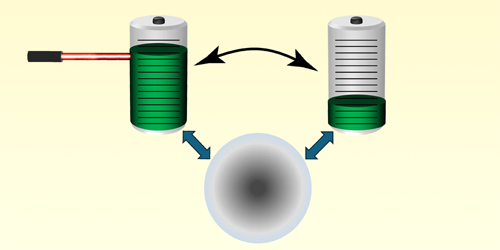A Better Way to Charge a Quantum Battery
Like any other battery, a quantum battery is a device that stores energy. But unlike its electrochemical counterparts, which are charged by flows of electrons, a quantum battery feeds on photons. Effects such as quantum entanglement and quantum coherence mean that a quantum battery can charge faster as you add more cells (see Viewpoint: Sizing Up the Potential of Quantum Batteries). Shabir Barzanjeh at the University of Calgary, Canada, and his colleagues now propose a charging protocol for a quantum battery that maximizes stored energy while minimizing energy dissipation during charging [1]. The novelty lies in inducing nonreciprocity, an invaluable element in optical and microwave signal processing that allows light to propagate asymmetrically along opposite directions.
A quantum battery charging system could potentially be built using any quantum system that breaks time-reversal symmetry. Barzanjeh’s version couples a charger (which could be realized by a microwave resonator) to a battery (which could be realized by a mechanical oscillator). An external pump supplies photon energy that gets exchanged between the battery and the charger. Unlike most quantum battery designs, the charger and the battery are simultaneously coupled to a shared reservoir. This results in an interference-like phenomenon where coherent coupling between the charger and the battery introduces a nonreciprocal flow within the system. This counteracts dissipative interactions with the battery’s surroundings, improving the energy transfer efficiency.
The researchers calculate a fourfold increase in energy stored in the battery during charging compared to conventional charging. They say that their version will lead to a quantum battery that has a higher capacity than those previously proposed or implemented. Their design works with both optical and microwave photons, making it compatible with superconducting qubits, nanoelectronics, and nanophotonics.
–Rachel Berkowitz
Rachel Berkowitz is a Corresponding Editor for Physics Magazine based in Vancouver, Canada.
References
- B. Ahmadi et al., “Nonreciprocal quantum batteries,” Phys. Rev. Lett. 132, 210402 (2024).




